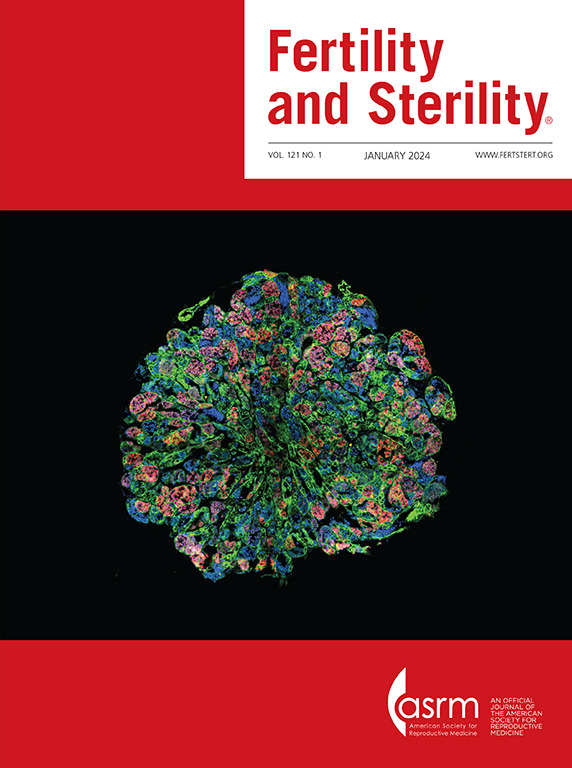平衡染色体重排患者的植入前基因检测和携带者状态检测:一项真实世界的多中心回顾性研究。
IF 6.6
1区 医学
Q1 OBSTETRICS & GYNECOLOGY
引用次数: 0
摘要
目的研究平衡染色体重排夫妇囊胚的整倍体率,评价分离载体定位等位基因(MaReCs)技术在区分非载体和载体胚胎中的准确性。设计:多中心、回顾性、队列研究。研究对象:我们纳入了2002对具有各种类型的平衡染色体重排(互惠易位、罗伯逊易位和倒位)的夫妇,他们在2017年1月至2023年9月期间接受了体外受精(IVF)治疗。采用着床前基因结构重排检测(PGT-SR)评估胚泡整倍性,采用MaReCs检测整倍体胚胎的载体状态。对于移植的整倍体胚胎,在妊娠16-20周进行羊膜穿刺术以检查胎儿染色体。羊膜穿刺术结果作为评价MaReCs技术准确性的金标准。染色体重排平衡的夫妇胚泡的整倍体率和MaReCs技术的准确性。结果共分析了2002对夫妇的2629个PGT-SR周期的13730个胚胎。64.3%(1287/2002)的夫妇在第一个可控卵巢过度刺激(COH)周期获得整倍体胚胎,占所有周期的63.5%(1670 / 2629)。囊胚总整倍体率为24.2%(3324 / 13730)。360个周期332对夫妇要求区分整倍体胚胎。共检出1021个囊胚,其中非携带者占49.4%(505/1021)。78.3%的患者(260/332)在第一个COH周期获得非载体胚胎。随访资料显示,122例羊膜穿刺术患者中,MaReCs与羊膜穿刺术的一致性为99.2%(121/122)。结论marecs是鉴别整倍体胚胎载体状态的一种简便、准确的方法,为染色体重排平衡患者阻止染色体重排遗传给下一代提供了可靠的解决方案。本文章由计算机程序翻译,如有差异,请以英文原文为准。
Preimplantation Genetic Testing and Carrier Status Detection in Patients with Balanced Chromosomal Rearrangements: A Real-World Multicenter Retrospective Study.
OBJECTIVE
To investigate the euploid rate of blastocysts in couples with balanced chromosomal rearrangements and to evaluate the accuracy of the mapping allele with resolved carrier status (MaReCs) technique in discriminating between non-carrier and carrier embryos.
DESIGN
Multicenter, retrospective, cohort study.
SUBJECTS
We involved 2,002 couples with various types of balanced chromosomal rearrangements (reciprocal translocations, Robertsonian translocations, and inversions), who underwent in vitro fertilization (IVF) treatment between January 2017 and September 2023.
EXPOSURE
Blastocyst euploidy was assessed using preimplantation genetic testing for structural rearrangements (PGT-SR), and the carrier status of euploid embryos was determined using MaReCs. For the transferred euploid embryos, amniocentesis was performed at 16-20 weeks of gestation to examine fetal chromosomes. The amniocentesis results were used as the gold standard to evaluate the accuracy of the MaReCs technique.
MAIN OUTCOME MEASURES
The euploid rate of blastocysts in couples with balanced chromosomal rearrangements and the accuracy of the MaReCs technique.
RESULTS
In total, 13,730 embryos from 2,629 PGT-SR cycles among 2002 couples were analyzed. 64.3% (1287/2002) of couples obtained euploid embryos in the first controlled ovarian hyperstimulation (COH) cycle and the percentage was 63.5% (1,670/2,629) of all cycles. The total euploid rate of blastocysts was 24.2% (3,324/13,730). 332 couples in 360 cycles requested to distinguish the euploid embryos. A total of 1021 blastocysts were discriminated, in which 49.4% (505/1021) were non-carrier. 78.3% of patients (260/332) obtained non-carrier embryos in the first COH cycle. Follow-up data showed that among the 122 patients undergoing amniocentesis, the consistency between MaReCs and amniocentesis was 99.2% (121/122).
CONCLUSION
MaReCs is a simple and precise method for distinguishing the carrier status of euploid embryos, providing a reliable solution for patients with balanced chromosomal rearrangements to stop the passing on of chromosome rearrangement to the next generation.
求助全文
通过发布文献求助,成功后即可免费获取论文全文。
去求助
来源期刊

Fertility and sterility
医学-妇产科学
CiteScore
11.30
自引率
6.00%
发文量
1446
审稿时长
31 days
期刊介绍:
Fertility and Sterility® is an international journal for obstetricians, gynecologists, reproductive endocrinologists, urologists, basic scientists and others who treat and investigate problems of infertility and human reproductive disorders. The journal publishes juried original scientific articles in clinical and laboratory research relevant to reproductive endocrinology, urology, andrology, physiology, immunology, genetics, contraception, and menopause. Fertility and Sterility® encourages and supports meaningful basic and clinical research, and facilitates and promotes excellence in professional education, in the field of reproductive medicine.
 求助内容:
求助内容: 应助结果提醒方式:
应助结果提醒方式:


